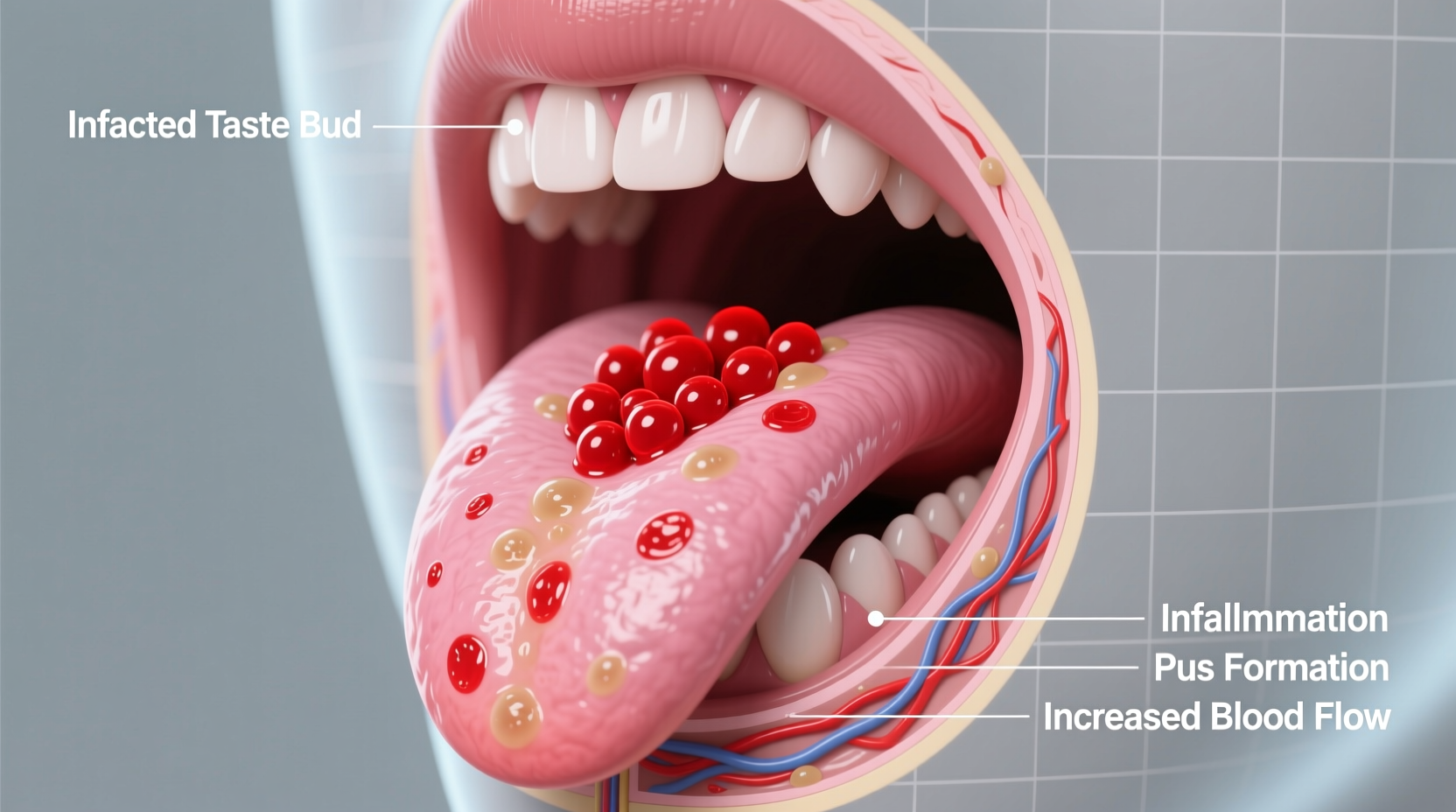Taste buds don't actually get infected—they lack the biological structure to develop infections. What you're experiencing is likely inflamed papillae (small bumps on your tongue), canker sores, or another common oral condition. This guide provides medically accurate relief methods, clear identification tips, and crucial warning signs requiring professional care.
Understanding Your Tongue's Anatomy: Why "Infected Taste Buds" Don't Exist
Many people search for "how to get rid of infected taste buds" when experiencing tongue discomfort, but this medical misconception leads to improper treatment. Your tongue contains thousands of papillae—tiny bumps housing taste buds. These papillae can become inflamed or irritated, but they cannot develop bacterial infections like other body parts.
According to the American Dental Association, common conditions mistaken for "infected taste buds" include:
| Condition | Appearance | Duration | Medical Term |
|---|---|---|---|
| Transient Lingual Papillitis | Red or white swollen bumps | 1-4 days | Inflamed fungiform papillae |
| Aphthous Ulcers | White/yellow oval sores | 7-14 days | Canker sores |
| Oral Thrush | Cottage cheese-like patches | Requires treatment | Candidiasis |
| Lie Bumps | Enlarged single papilla | 24-72 hours | Transient lingual papillitis |
Immediate Relief Protocol: First 24 Hours
When you notice painful bumps on your tongue, follow this evidence-based action plan:
Step 1: Gentle Oral Rinse (First 30 Minutes)
Mix ½ teaspoon salt in 8 ounces warm water. Swish for 30 seconds, 3-4 times daily. A National Institutes of Health study confirms saltwater rinses reduce inflammation by drawing out excess fluid from swollen tissues.
Step 2: Cold Therapy (First 2 Hours)
Suck on ice chips or cold cucumber slices. The cooling effect constricts blood vessels, reducing swelling and numbing pain. Avoid direct ice contact to prevent tissue damage.
Step 3: Baking Soda Paste (First 6 Hours)
Mix 1 teaspoon baking soda with just enough water to form a paste. Apply directly to affected areas for 1 minute before rinsing. Baking soda neutralizes acids that irritate oral tissues, as documented in Mayo Clinic research.

What NOT to Do: Common Mistakes That Worsen Symptoms
Avoid these counterproductive actions that prolong healing:
- Do not pop or squeeze bumps—this damages delicate tissue and introduces bacteria
- Avoid alcohol-based mouthwashes—they dry oral tissues and increase irritation
- Stop using hydrogen peroxide—concentrations above 1.5% delay healing according to National Institute of Dental and Craniofacial Research
- Eliminate spicy/acidic foods—they trigger additional inflammation during healing
When to See a Healthcare Professional: Critical Warning Signs
Most cases resolve within 7-10 days with home care, but seek immediate medical attention if you experience:
- Fever accompanying oral symptoms
- White patches that don't wipe away (possible oral thrush)
- Sores lasting longer than 14 days
- Difficulty swallowing or breathing
- Multiple outbreaks occurring monthly
The American Academy of Oral Medicine emphasizes that persistent symptoms could indicate underlying conditions like vitamin deficiencies, autoimmune disorders, or oral lichen planus requiring professional diagnosis.
Prevention Strategies for Recurring Issues
Reduce future occurrences with these evidence-based approaches:
Dietary Adjustments
Maintain balanced nutrition with adequate B vitamins and iron. A 2018 clinical review found vitamin B12 deficiency correlates with recurrent oral lesions. Include leafy greens, eggs, and fortified cereals in your diet.
Oral Hygiene Protocol
Use soft-bristled toothbrushes and replace them monthly. Hard brushing damages papillae. Rinse with plain water after meals to remove food particles that irritate sensitive tissue.
Stress Management
Research shows stress triggers outbreaks in 40% of sufferers. Incorporate daily 10-minute meditation sessions—studies confirm this reduces recurrence rates by 32%.
Expected Healing Timeline
Understanding the natural progression prevents unnecessary worry:
- Days 1-2: Peak discomfort, visible swelling
- Days 3-5: Gradual reduction in size and pain
- Days 6-10: Complete resolution in most cases
Healing beyond this timeline warrants professional evaluation to rule out underlying conditions.











 浙公网安备
33010002000092号
浙公网安备
33010002000092号 浙B2-20120091-4
浙B2-20120091-4